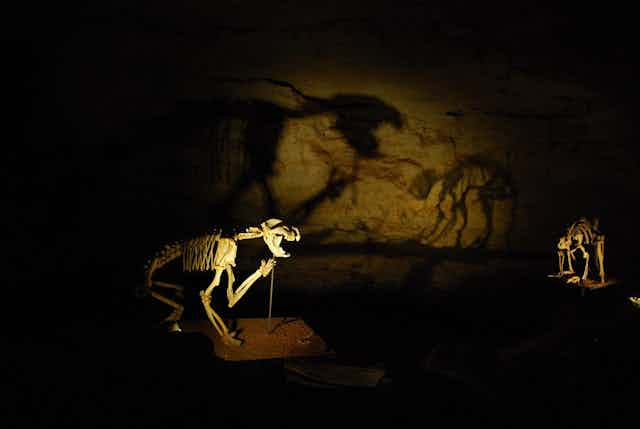Australia was once home to gigantic reptiles, birds and marsupials, but sadly they’re no longer with us. What happened to them has been a source of ongoing debate, whether it was human hunting, climate change, uncontrolled burning or something else.
But in new research published today in Proceedings of the Royal Society B we test one hypothesis: that when people arrived in Australia, they altered the landscape with fire so significantly that it drove the megafauna to extinction.
The megafauna extinction debate hinges on the coincidence of the arrival of Aboriginal Australians around 45,000 years ago, and the impacts they had on Australia’s environment, including extinctions. Some scientists have suggested Aboriginal people drastically transformed the ecology of Australia.
The hypothesis is that through sustained burning Aboriginal people wiped out fire sensitive “dry rainforest” that once grew across inland Australia. This changed the vegetation to flammable eucalypts and spinifex grasslands, and drove Australia’s megafauna extinct.
How do we test this hypothesis? In our new research we looked at a particular kind of fire-sensitive native pine tree (species of Callitris). These native pine trees are widespread in Australia, but are only found in isolated populations. In northern Australia the pines are declining, probably because skilful and patchy Aboriginal burning practices have been replaced with more frequent large-scale fires.
So we know native pine trees are sensitive to fire, and that they are found in isolated patches right across Australia. How does this help us with the megafauna question?
By looking at the population genetics of the trees we can calculate when the native pines became genetically isolated from each other. If the trees became isolated around 45,000 years ago it would seem likely that Aboriginal Australians radically changed Australia’s fire regimes, in turn killing off the megafauna.
We analysed specific DNA markers in the pine tree genomes. We were looking specifically for population “bottlenecks”. When populations shrink and stop exchanging genes with each other they lose genetic diversity and risk becoming inbred. Looking at changes in genetic diversity tells us if and when a population of animals or plants goes through a period of decline.
We found three different results in the pine trees’ DNA. The first was that pines in the monsoon tropics showed no evidence for a population bottleneck. Second, pine trees in the arid zone showed bottlenecks around 18,000 years. Third, pine trees in the temperate zone rapidly increased and expanded around 10,000 years.
These dates don’t match human arrival in Australia, but they do broadly recapitulate Australia’s climate history. Around 18,000 years ago was the height of the last ice age when central Australia was dry, windy, and colder than today. Around 10,000 years ago was the end of the last ice age where warmer conditions favoured tree growth in previously treeless areas. The monsoon tropics have always been dry and hot, so no changes were expected in these areas.
The results suggest that Aboriginal Australians had a negligible impact on fire sensitive vegetation such as the native pines. Instead, the colonists may have been already highly skilled in using fire to manage landscapes.
This finding doesn’t necessarily rule out other causes of the megafauna extinction. It could be that Aboriginal hunting did have a role to play. But this study reinforces the huge role climate has played in shaping Australia’s landscapes, flora, and fauna. It shows that when we’re looking at past events such as the megafauna extinction, we should always remember climate - both regional patterns and periods of change.

